Saudi National Bank
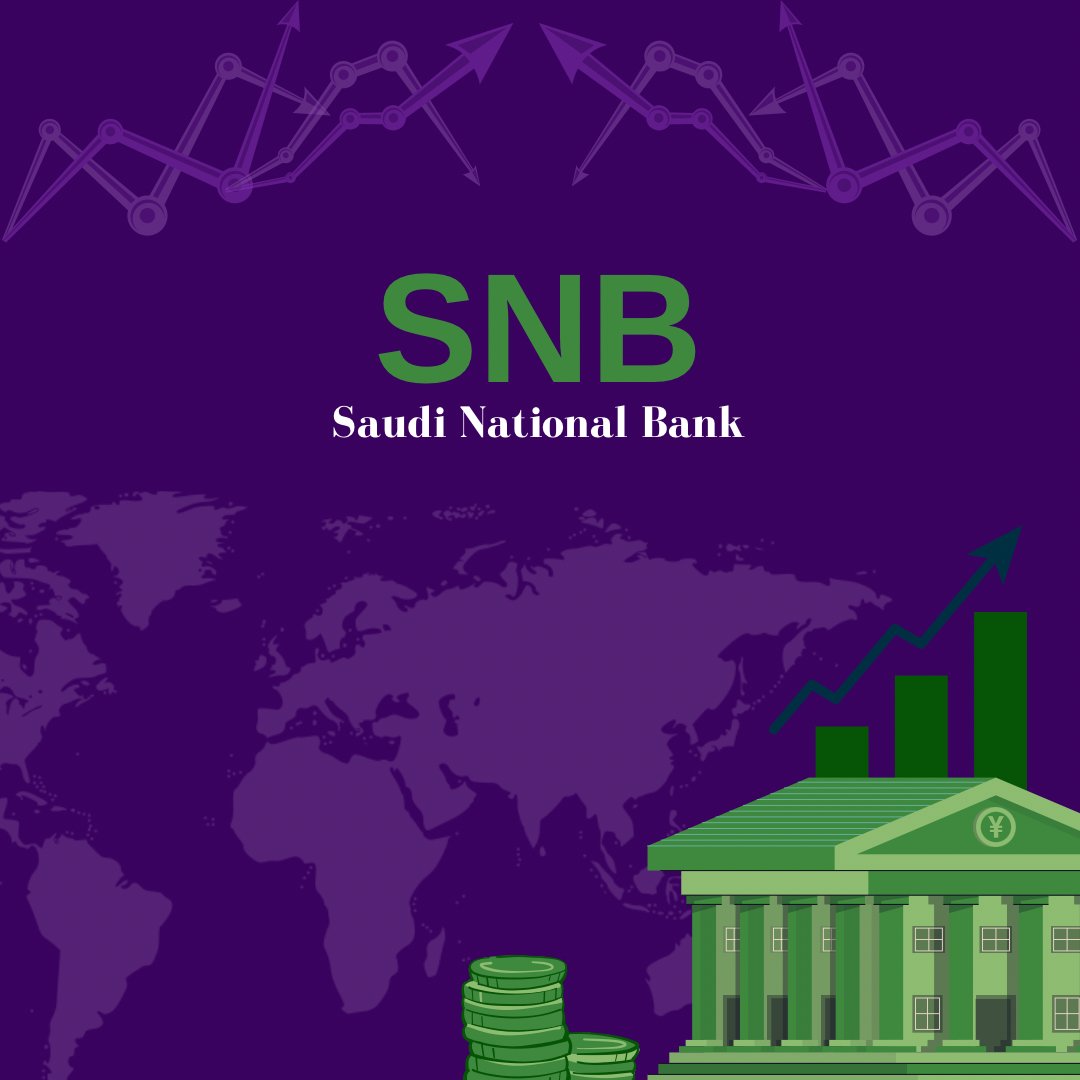
The Saudi National Bank (SNB) is the first Saudi bank to be established and is considered an extension of two ancient banks (Samba and Al-Ahli). It is also the largest financial institution in the Kingdom of Saudi Arabia, as it has a strong budget and many capabilities that help achieve development in the sector and achieve the goals of Vision 2030. It is also the first local institution to invest abroad, which is one of the goals of the vision that has been achieved.
Over the years, the bank has achieved several achievements and won many different awards, including the award for the best bank in payments and collection in the Middle East for the year 2022, the best trade finance bank in the Kingdom in 2022, and the first bank in the Middle East by tier capital for the year 2022 from The Banker Magazine, among many other awards and titles that put the Saudi National Bank at the forefront of the national economy, in addition to its social responsibility and keenness to provide the best banking services to its beneficiaries. It has 374 branches across the Kingdom of Saudi Arabia and seeks to reach the largest segment of beneficiaries.
The bank took many steps, the most famous of which was its earlier merger with Samba Bank on 17/7/1442, corresponding to 1/3/2021, and it was the fastest merger that contributed to the formation of a competitive financial force that makes the Saudi banking sector ready to compete locally and globally.
And on the date of October 26, 2022, the National Bank announced its intention to invest $1.50 billion in the Credit Suisse Group, which is one of the largest wealth managers in the world and one of the most important global banks. The National Bank has stated that this partnership will lead to the creation of added value for shareholders in addition to the investments that have already been made. Credit Suisse Bank has recently faced problems that led to a significant decrease in the share price, which affected the National Bank of Saudi Arabia, of course, as it is one of the largest shareholders, as it owns 9.88% of the shares of the Credit Suisse Group. The bank achieved unrealized book losses due to the decline in the Credit Suisse share price, but it was the least of the losses among the main shareholders, as its losses amounted to 684 million francs (742.1 million dollars).
Since it was mentioned about the achievements, services, and investments of the bank and its position and impact on the Saudi economy, it is important to take a financial look at the bank and its lists, as well as to review together the services provided by the bank, and we will also address the developments of the Saudi banking sector and its future.
Due to the mention of the bank’s achievements, services, investments, and impact on the Saudi economy, it is important to review the bank's financial statement to see its financial position and the services it provides. We will also address the Saudi banking sector's developments and its future.
The size of the global commercial banking sector
In 2021, the value of the global commercial banking services market reached 2540.30 billion, and by 2031 this value is expected to reach 7404.4 US dollars.
In 2023, the number of commercial banks reached around 10,334 in the world.
Commercial banks grow based on many factors, including mergers and acquisitions, innovation in banking technologies, providing the best experiences for customers, the increase in financing solutions, and some banks have succeeded in applying these methods more than others, in the chart below an arrangement of the top 5 commercial banks based on revenue and market value.
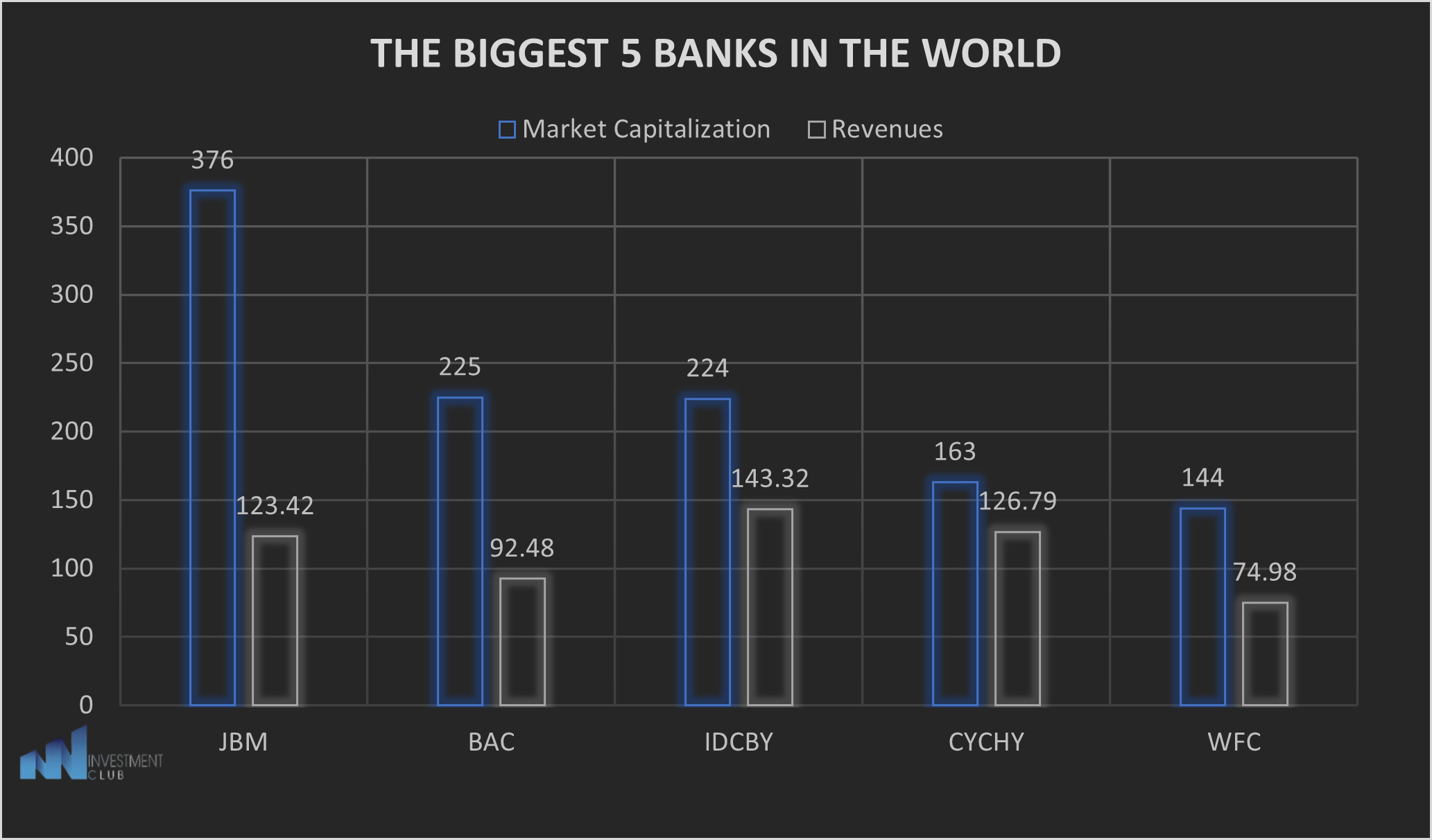
Figures are in billions and US dollars
Market capitalization is the value of companies based on the total value of all traded shares. We note that the Commercial Bank (JB)
Or what is known as JPMorgan, which has the largest market value in the world, equivalent to 376 billion, and it is an American bank established in 1799 and located in New York. JPMorgan acquired several banks to become the largest bank in the United States.
ICDBY, or what is known as the Industrial and Commercial Bank of China, occupies the first place for the largest bank in the world based on its revenues in the commercial banking sector, and in June 2008 the bank announced its entry into the Saudi market, thus becoming the first Chinese bank in the Kingdom of Saudi Arabia.
The commercial banking sector in the Kingdom of Saudi Arabia
There are 11 licensed local commercial banks in the Kingdom and 17 other foreign banks, and the number of operating branches in the Kingdom reached 1927, led by Al-Rajhi Bank with 515 branches in the first half of 2022.
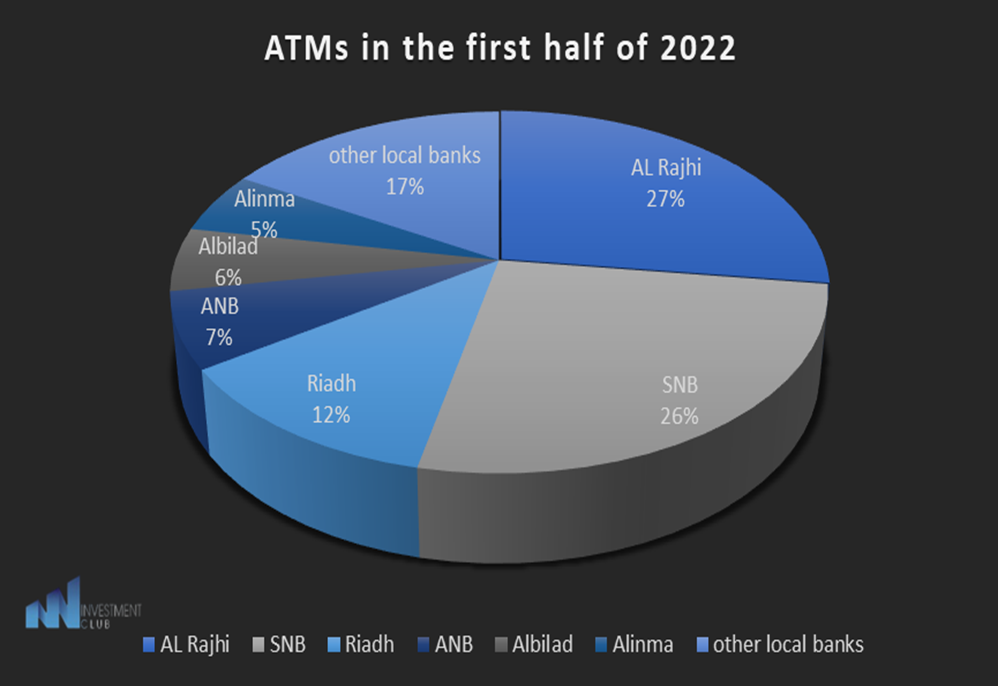
At the beginning of 2021, the combined market value of Saudi banks exceeded the equivalent of 1047.3 billion riyals for the first time in the history of the market. During the third quarter of 2021, 10 commercial banks in the Kingdom achieved profits estimated at 13.25 billion, while for the year 2020, they achieved 10.66 billion in the third quarter. We note the huge growth rate and the rapidity of the banking services sector overcoming the epidemic crisis.
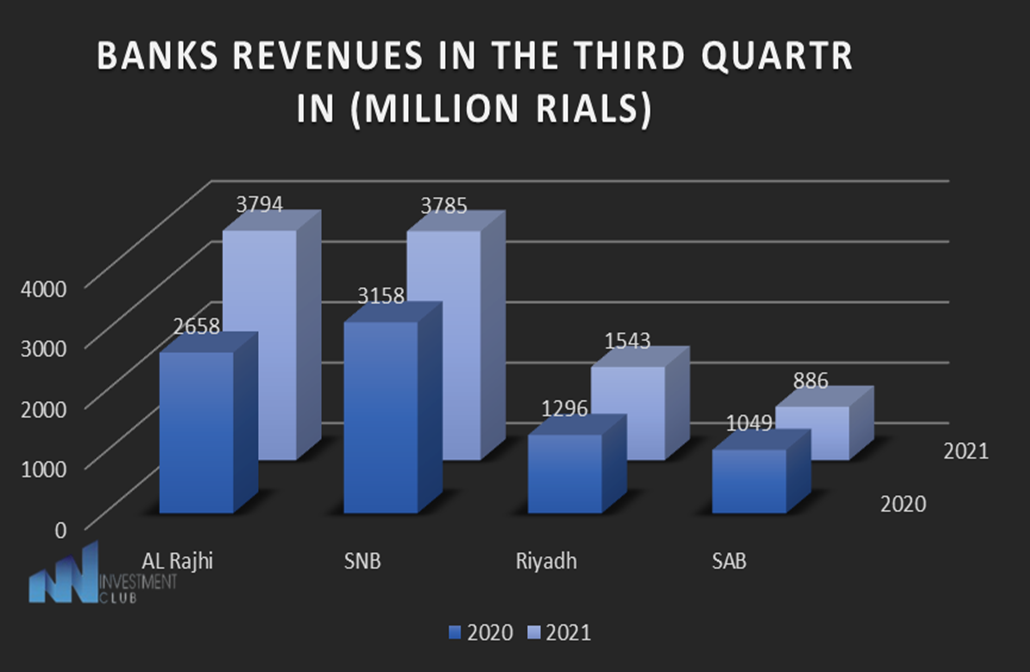
In 2021, Al-Rajhi Bank achieved profits estimated at 3794 million Saudi riyals, followed by Al-Ahly Bank, with a difference of 9 million, equivalent to 3785 million Saudi riyals, followed by the rest of the banks that are not comparable to the magnitude of Al-Rajhi and Al-Ahly in the Kingdom Saudi Arabia.

AlAhli bank's market share is 24.4% in the third quarter of 2022, increasing from 22.3% in the first quarter of 2021 to 25.3% in the third quarter of 2022.
The services provided by the bank:
AlAhli Bank provides many services to individuals, companies, and others, among the services provided by the bank:
• Opening a current account to conduct banking transactions such as transfers and deposits.
• AlAhli Payment: It is a government program that gives all bank customers the possibility Pay their government bills via the Internet, mobile, or ATM.
• Financing for small and medium enterprises to increase capital or expand business in ways that are consistent with the principles of Islamic law by providing financing solutions such as Murabaha, facilitating access to goods.
• Providing iCorp service to companies and small and medium enterprises through electronic payments, managing accounts on the Internet, international transfers, immediate processing of banking transactions and other services.
• Corporate banking services: It provides the company's customers with the ability to receive accounting reports by companies from the ERP accounting system and aims to reduce the accounting and operational costs of the company.
• Financing projects such as: real estate financing, Supporting assets with securities, syndicated loans.
• Trade finance in accordance with international and local laws in the Kingdom of Saudi Arabia for all customers regardless of the size of the activity.
• Private banking services that meet the needs of customers, the most important advantages of which are: a private wealth manager to study the client's investment needs, exemption from annual membership fees, specialized branches located in (Jeddah, Mecca, Riyadh, AlKhobar) and other advantages.
Developments of the sector
The Kingdom of Saudi Arabia is making significant progress in transforming its economy in accordance with its Vision 2030. This is being done through several mega-projects, modernization initiatives, and reform and development plans that are already diversifying the Saudi economy and opening it up to the world in a way it has not done before. This is reflected in the performance of the banking sector, which is enjoying a period of much-needed profitability.
The banking industry has undergone radical transformations over the past few decades. The advent of new technologies and the rise of agile fintech startups has disrupted traditional banking models significantly. The industry is now at a crossroads, facing new challenges and opportunities that could transform it in the coming years. Digital banking is rapidly reshaping the banking landscape, creating new opportunities for growth, and increasing competition. Banks are investing heavily in enhancing their digital capabilities to meet the growing demand for online services. Many traditional banks have launched mobile apps, online platforms, and other digital services to improve customer experience and streamline operations.
Fintech has experienced explosive growth in recent years as new businesses and technologies have transformed the way we think about banking and finance. The future of financial technology in Saudi Arabia today is in continuous and rapid development, and today the Kingdom is considered one of the fastest countries to accept and become accustomed to new technologies in the market. The Saudi Fintech report indicated that the growth in the number of emerging companies in the field of financial technology reached 147% in the annual cumulative growth rate between 2018 and 2020 as well as the Central Bank approved the license of the first two digital banks in the Kingdom after meeting the requirements and standards for practicing the banking system in the Kingdom.
Banks will be able to realign in the future to compete in new markets built around specific consumer needs. These markets, which substantially go beyond the current definition of financial services, will see strong competition from several tech giants, tech start-ups, and other nonbanks. But this challenging restructuring or separation might also provide banks with a substantial opportunity, new revenue sources, higher valuations, and greater margins.
The future of banks is exciting yet uncertain, as the industry faces new challenges and opportunities. Banks that can adapt to changing customer expectations, embrace new technologies, and collaborate with other players will thrive in the coming years. The industry will also need to balance innovation with regulation, ensuring that customer protection remains a top priority. Overall, the banking industry is evolving, and those that can navigate the changes will emerge as winners.
Changes in the banking industry
Lately, the headlines and news of the global banking industry have become the center of attention as the issues have increased with the news and outcomes that have been distributed.
According to the Governor of the Central Bank of Saudi Arabia, these issues encountered by the global banking industry, particularly the failing American, did not influence local Saudi banks. This positive connotation reflects the Saudi banking sector's liquidity and capital efficiency, which helped it withstand the present global economic crises.
After the release of the Saudi banking sector's annual financial reports for the year 2022, it was said that the data provided for the 10 banks in the Saudi Tadawul suggest good performance, such as a rise in net profit of 28%, or 62.71 billion Saudi riyals. This data demonstrates the extent to which growth may continue to support both public and private sectors, as well as the quantity of non-interest-bearing deposits.
The total assets of Saudi banks increased by 11.5%, to 3.832 billion Saudi riyals, while deposits increased by 8.34%, to 2.296 billion Saudi riyals, and the banking sector continued to reap the benefits of economic growth, as evidenced by an increase in borrowing rates, which reached about 95.5% at the end of 2022, and an increase in lending accounts of 14.44% on an annual basis.
What distinguishes the year 2022 from the previous year is that the increase in net profit has resulted in a significant decrease in expected credit losses by 19.25% compared to 2021, equivalent to 9.87 billion Saudi riyals; This contributed to his success in better navigating the Corona pandemic crisis by utilizing the various aspects of the sector.
Timeline important of SNB:

After getting to know the bank, its activities, and its most important events, we will take a quick look at its three biggest competitors:
Riyad Bank
Riyad Bank is one of the largest financial institutions in the Kingdom and the Middle East and the third largest bank in the Gulf in terms of market capitalization, followed by the First Saudi Bank (Alawwal- SAB). Riyad Bank is one of the competitors to the Saudi National Bank.
The bank has 338 branches in the Kingdom, a branch in the United Kingdom, a Houston agency in the United States, a representative office in Singapore, and soon one in China. It provides many services to individuals, including personal finance, car financing, and real estate financing, and provides services and products for small and medium enterprises; in 2022, it was the top financing entity for small, medium, and micro enterprises with a market share of 22%.
In 2022, Riyad Bank was the highest bank to achieve profits, with a growth rate of 16.5% over the profits of the previous year, achieving 7.0 billion Saudi riyals in net profits. The current capital of Riyad Bank is 30 million riyals. The Bank has made significant efforts to achieve Vision 2030 by establishing initiatives in support of digital transformation, private sector development, and the development of economic partnerships, including the Culture Road Program, a financing program supported by the Cultural Development Fund, and the initiatives of 'Obour' and "We Finance, You Manufacture".
The Bank has several sectors, including retail banking, Riyad Capital, corporate banking, treasury, and investment.
The Alawwal Bank
The Alawwal Bank is the largest bank in Saudi Arabia and is in fourth place as one of the largest Gulf banks in terms of assets amounting to $ 5.5 billion. It is also the fourth largest bank in the Kingdom with a capital of 20.5 billion riyals. It is one of the competitors of the Saudi National Bank.
It is one of the leading international banks for companies and institutions in the Kingdom. The bank was formerly known as the British Saudi Bank (SABB), but after the legal merger with Alawwal Bank, known as Saudi Hollandi Bank, the name of the bank was changed to become the First Saudi Bank, and the brand was changed to (Alawwal-SAB). The bank has two subsidiaries, HSBC Arabia, and Alawwal Investment, and in 2021 the bank completed the sale for the transfer of certain business lines from HSBC Saudi Arabia to Alawwal Investment Co.
At the end of 2022, the bank achieved an increase in profits to 4.8 billion riyals, and the bank witnessed an increase in assets of 15% to 314 billion riyals. It also saw an increase in net income due to growth in total operating income during 2022. The bank has several programs that benefit the community, including the "Riyali" program for financial awareness in cooperation with the Ministry of Education, the "Taqaddam" program, the SAB Digital Academy, and the accelerator program for people with special needs.
Al Rajhi Bank:
Al Rajhi Bank is one of the largest banks in the world in terms of assets and capital with total assets of 710 billion SAR and a total capital of 40 billion SAR and is considered one of the largest competitors to Alahli Bank in the market with a market share of 25.3% in the third quarter of 2022.
Some of the services provided by Al Rajhi:
• Cash management: such as automatic salary transfer, money transfer even on official holidays, cash deposit card, corporate liquidity management.
• Real Estate Finance: Where financing solutions are provided to suit all the needs of the customer.
• Contract financing: Protection is made against delayed payments and timely receipt of dues.
• Car Finance: There is an easy payment system.
• Supply Chain Finance: Providing liquidity to suppliers on flexible terms.
• Letter of Credit: A letter of credit issued by Al Rajhi Bank is used to increase trust between business partners.
• Sea Cargo Insurance: to cover transportation and shipping risks.
• And many insurances such as: insurance against machinery breakdown, insurance of funds deposited in the treasury, engineering insurance.
We will now review a comparison between SNB
and its three competitors using several financial ratios:
Debt ratio:
The term debt ratio refers to a financial ratio that measures how leveraged a company is. The debt ratio is defined as the ratio of total debt to total assets, expressed as a decimal or percentage. It can be interpreted as the proportion of a company's assets that are financed by debt. The higher this ratio, the greater the amount of debt-financed assets of the company.
Banks usually depend on indebtedness more than equity because investors in stocks bear more risks, so the investor demands higher returns or in addition to bearing these risks, and it costs banks more than the interest cost of indebtedness, and the other reason is that the stock market has more volatility than the volatility of the bond market.
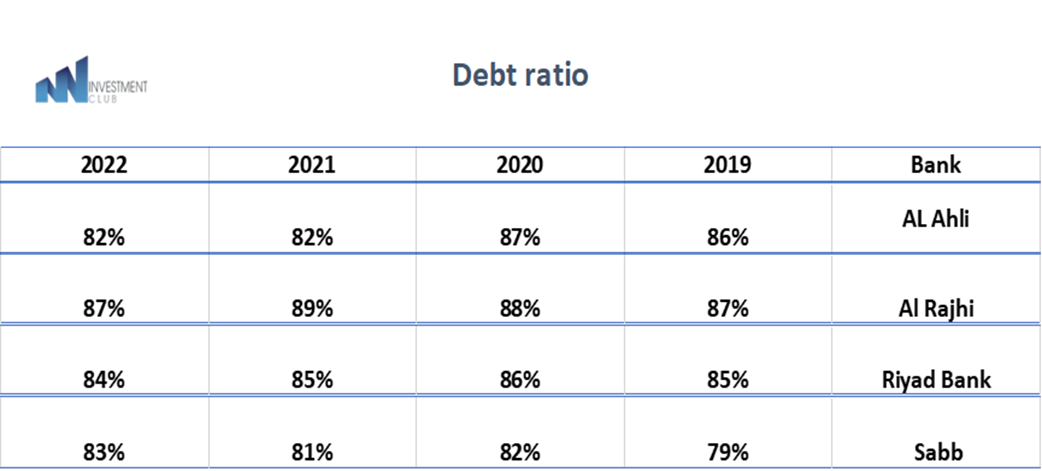
In the previous table, we note that Al-Rajhi Bank topped in previous years due to its high debt ratio, followed by Riyad Bank. As for Al-Ahli Bank of Saudi Arabia, it achieved a low ratio in 2022 compared to other banks Due to the increase in the profits of the National Bank of Saudi Arabia to 18.6 billion riyals, and in November 2022, Credit Suisse announced that it had issued 462 million new shares to qualified investors to increase its capital, among them was the National Bank of Saudi Arabia, which bought 307 million new shares to obtain a 9.88 percent stake in the bank. In contrast to previous years, the bank’s reliance on indebtedness was higher by a difference of 1% and 2%.
ROE ratio:
Return on equity is the amount of net income returned as a percentage of equity. Because shareholders' equity is equal to a company's assets minus its debt, return on equity is considered return on net assets.
Return on equity is a measure of a company's profitability and how effective it is at making profits. The higher the return on equity, the more efficient the company's management is at generating income and growth from equity financing.
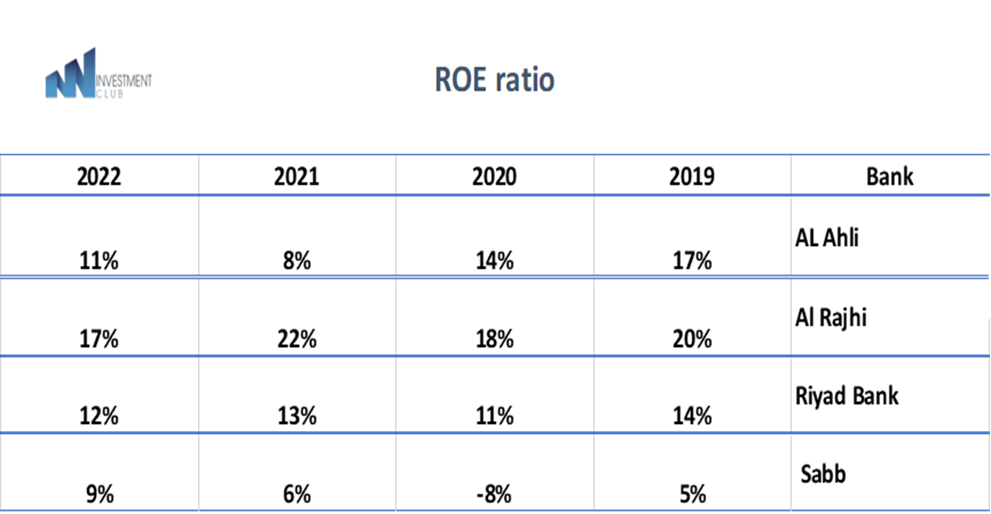
The National Bank achieved good returns for shareholders and investors, and in 2021 the return on equity reached 22%, which is the highest percentage for the National Bank of Saudi Arabia during the m four years.
As for its competitors in the banking sector, the biggest competitor is Al-Rajhi Bank, as the rates of return on equity were the highest among other banks. In 2021, Al-Rajhi Bank achieved 22%, with a difference of 14% from Al-Ahly Saudi Arabia. The bank said that the reason for the increase in profits during the current period compared to the same period of the previous year is due to the increase in total operating income by 24.1%, as a result of the increase in net income from financing and investment, income from banking fees, income from other operations, as well as income from transferring foreign currency. As for the reason for achieving the Saudi British Bank (SABB) -8 in 2020, it is to achieve losses of 4168 million riyals, compared to profits of 2736 million riyals achieved during the same period in 2019.
The bank said, “The reason for recording losses is the decrease in total operating income, mainly due to the decrease in net special commission income, dividend income, the unprecedented Covid-19 pandemic and the unexpected appearance, and its impact on the economy, which contributed to the result of expectations of future returns related to the decline in value.”
Asset Turnover:
To begin, the asset turnover rate is utilized to calculate the sales value of a corporation. It is a measure of a company's efficiency and ability to use its assets to generate money, hence a high rate is a good sign, and vice versa.
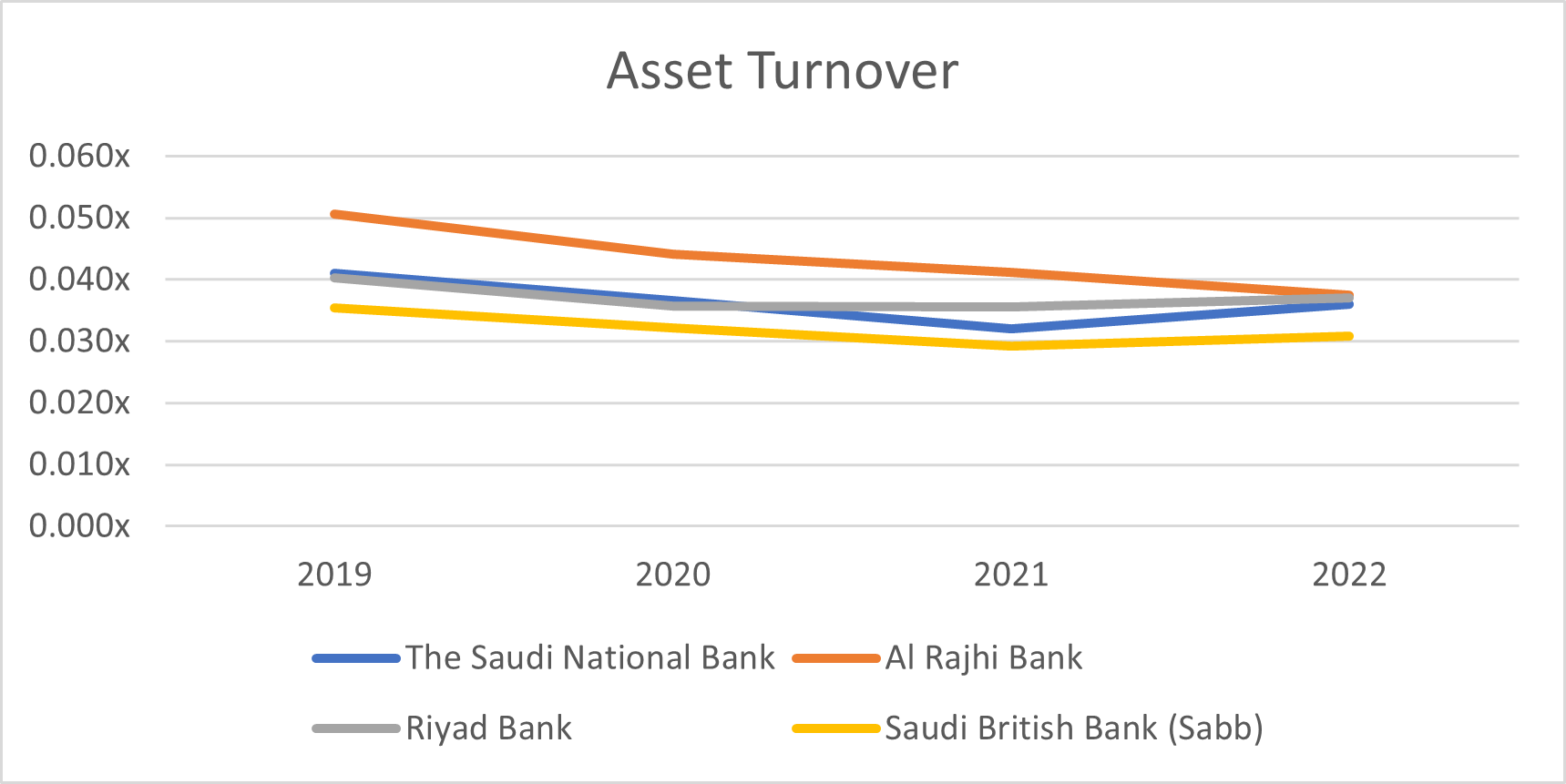
According to the results, Al-Rajhi Bank (the competition) has taken first place and has demonstrated its worth in effectively utilizing its assets to create money. Riyad Bank was ahead of it by a difference of (0.0035) in the years 2019 and 2020, and by a difference of (0.001) in the years 2021 and 2022.
For 4 years, the average asset turnover ratio of banks was as follows: first place Al Rajhi 4.33%, second place for Riyadh 3.72%, followed by Al Ahli 3.64%, and finally SABB 3.19%.
We note that in 2019, the percentage of Al-Ahly Bank of Saudi Arabia reached its highest percentage in recent years, until it reached 4.10%, and that although the assets were the lowest among the years, that this is due to the extent of the company's efficiency at this time, whereas in recent years, the bank increased its assets and jumped by a large percentage compared to the volume of sales, which did not reflect on such an increase positively.
It is important to mention that the lowest percentages were for SABB Bank specifically for the year 2021, as it reached its lowest level, reaching 2.92%, which is lower than the average of 3.19% for the same bank in the rest of its years, due to the bank's performance and sales for the rest of the years.
Current ratio:
The current ratio evaluates a company's capacity to pay off its current liabilities within a year. This means that a high value for this ratio reflects the company's efficiency and financial strength, and vice versa.
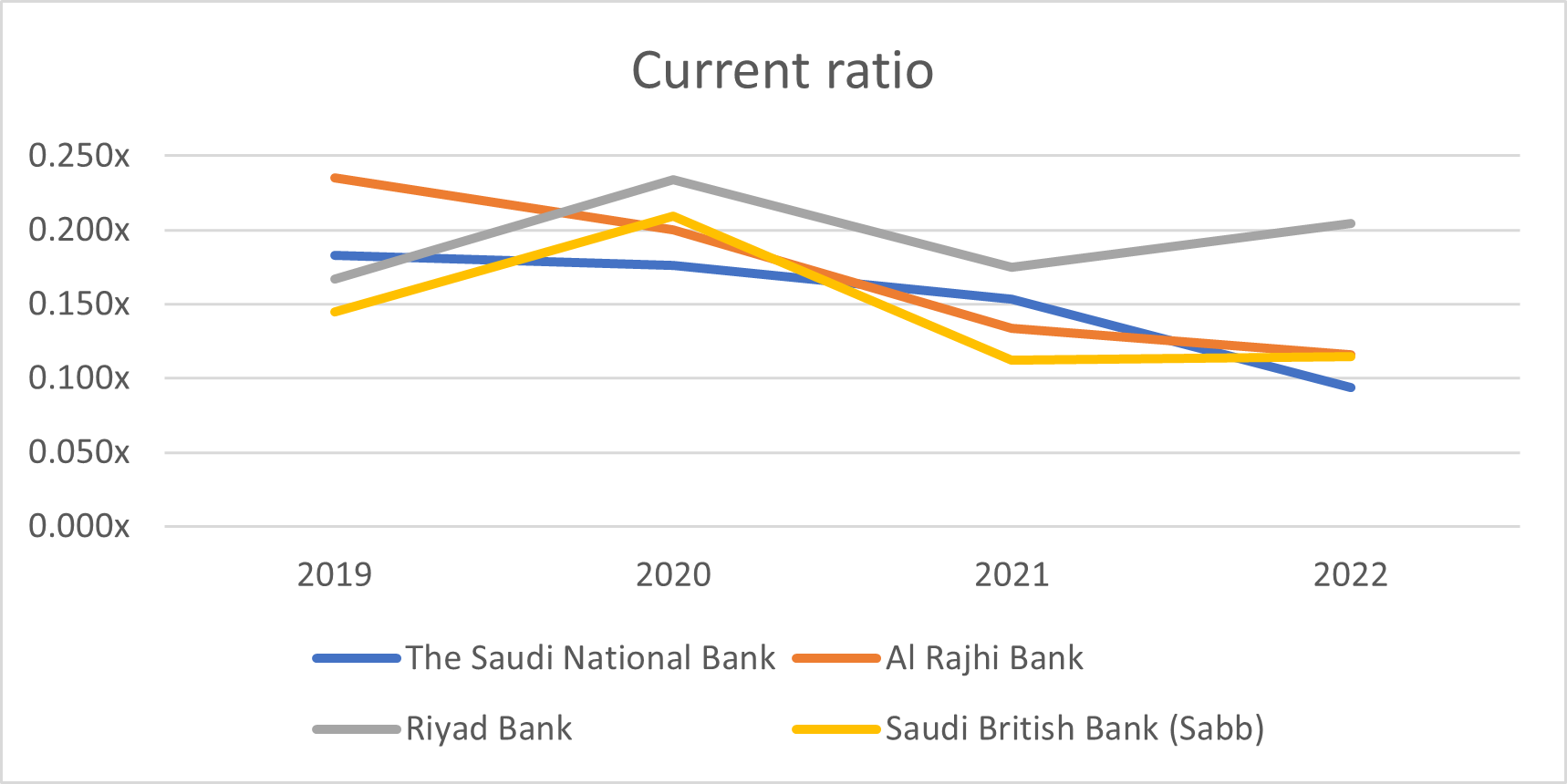
We see a decrease in the percentage of the National Bank of Saudi Arabia to reach its lowest percentage by 9% for the year 2022 compared to its competitors because of a sharp decline in its assets to reach 61,665,183 from the rest of the years and an increase in its liabilities amounting to 685,732,390, as well as an increase in the percentage of Al-Rajhi Bank to reach 24% in 2019. Because of the drop in liabilities in that year, it achieves the highest percentage compared to other banks for all years.
We see a decrease in the percentage of the National Bank of Saudi Arabia to reach its lowest percentage by 9% for the year 2022 compared to its competitors because of a sharp decline in its assets to reach 61,665,183 from the rest of the years and an increase in its liabilities amounting to 685,732,390, as well as an increase in the percentage of Al-Rajhi Bank to reach 24% in 2019. Because of the drop in liabilities in that year, it achieves the highest percentage compared to other banks for all years.
We note the development of Riyad Bank for the last three years, as it achieved the highest position over the rest of the banks due to the fact that it is the only bank that was able to maintain the level of its liabilities so as not to exceed 300,000,000 and the continued rise of its assets, and SABB Bank achieved the last place among the four banks, as the level of their liabilities was increasing while its assets continue to decline, and it achieved its only jump in 2022 among its years, due to the contribution of its rising assets in that year to reach the highest level of assets, which led to an increase in the trading percentage to reach 21%.
ROA ratio:
Return on Assets Rate: Equal to the net operating profit on total assets calculated the company's ability to achieve profits from the assets that have been invested in or measure the effectiveness of the use of available resources is calculated by net operating profit on the average total assets as we see in the beginning the highest ratio for Al Rajhi Bank, Ahli, Riyadh and then the British.
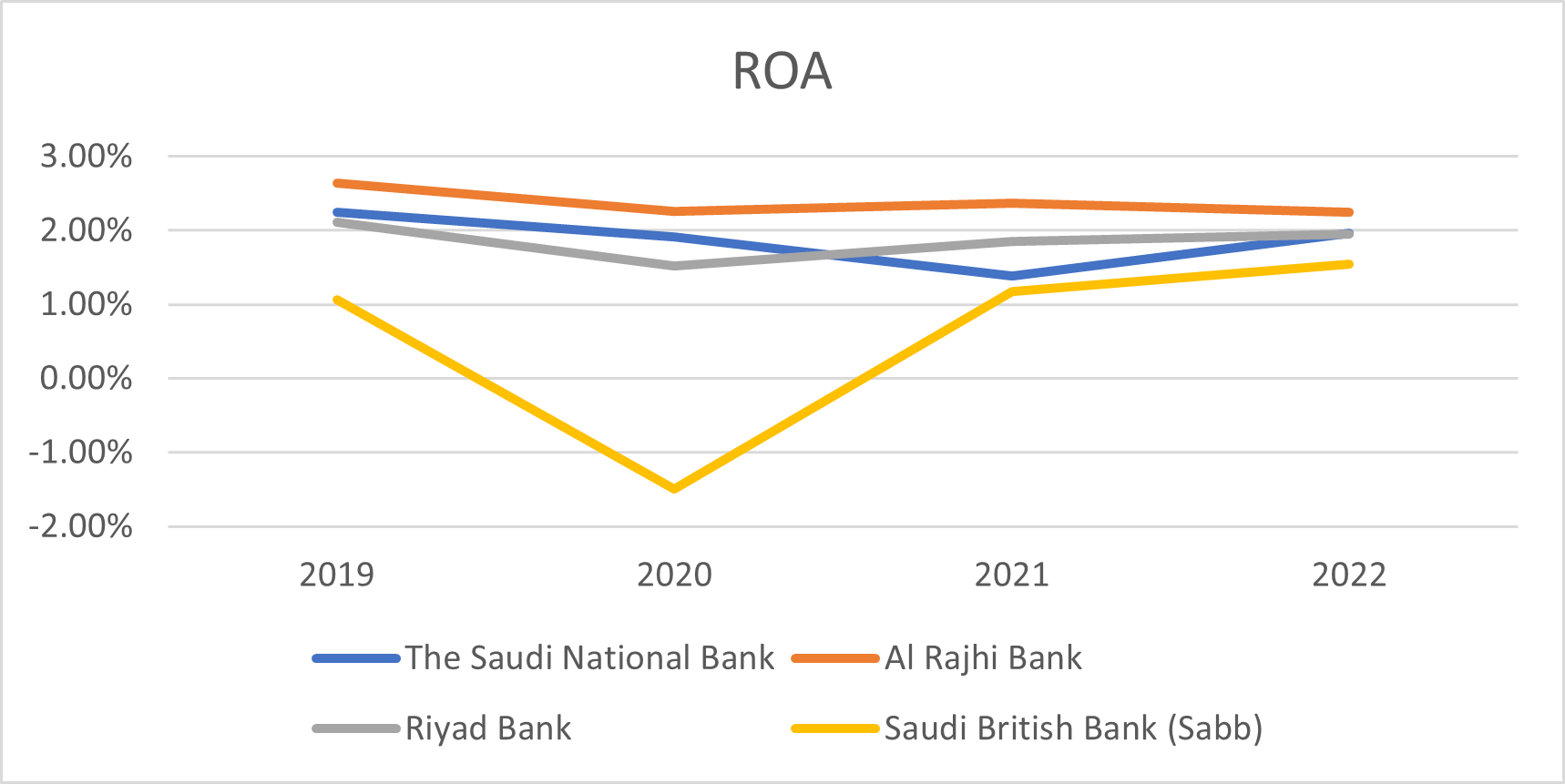
In 2020, the return ratio decreased from the previous year due to the crisis, but the rise in the value of most commercial banking services at that time was a reason to reduce the impact of the decline on the return on assets, as the decrease in return on assets for retail banking was about 2.2%, while the return on assets for corporate banking decreased significantly and did not exceed 0.7%. This comes after the exclusion of the impairment provision for SABB as it was fully proven in one year and is considered a non-recurring loss and its exclusion from the study provides a fair reading of statistics also the main reasons for the rapid decline in the rate of return were the decline in the price of SIBOR to less than 1% and the rise in bad loan reserves.
Cash ratio:
The cash ratio is a measure of the company's ability to pay its obligations, such as debts, either in the form of cash or Cash Equivalents such as securities. An increase in the cash ratio means that the company can pay its obligations.
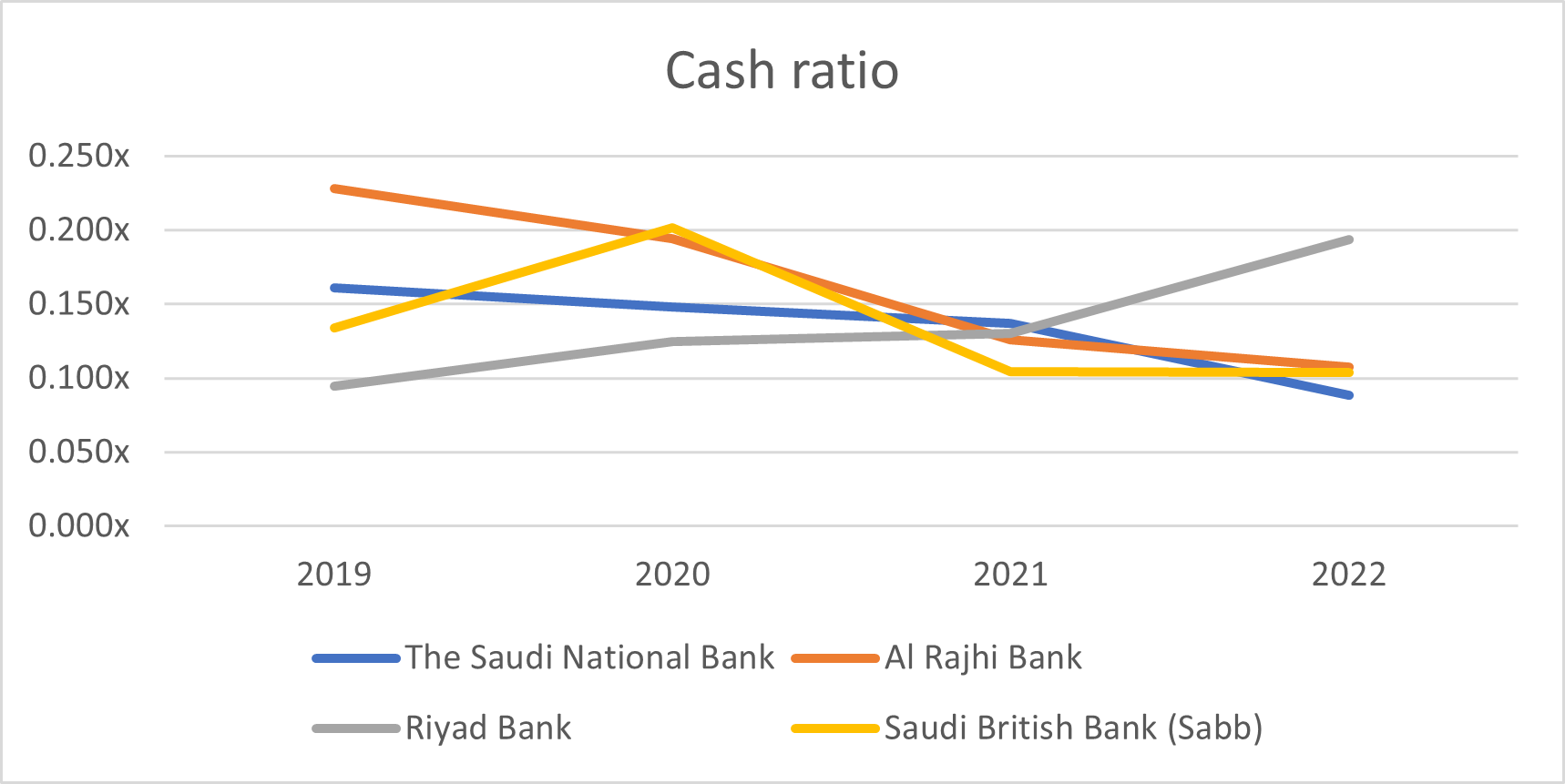
The percentage table for Al-Rajhi Bank in 2019 is equal to 22.8%, which is the highest percentage, which means that Al-Rajhi Bank is the highest in repaying the remaining debts, then it comes in second place, Al-Ahli Bank of Saudi Arabia. Al-Rajhi Bank ranked second with a rate of 10.74%, and Al-Ahli Bank of Saudi Arabia took the last place with a rate of 8.81%.
Finally, we review a summary of the charts that have been mentioned:
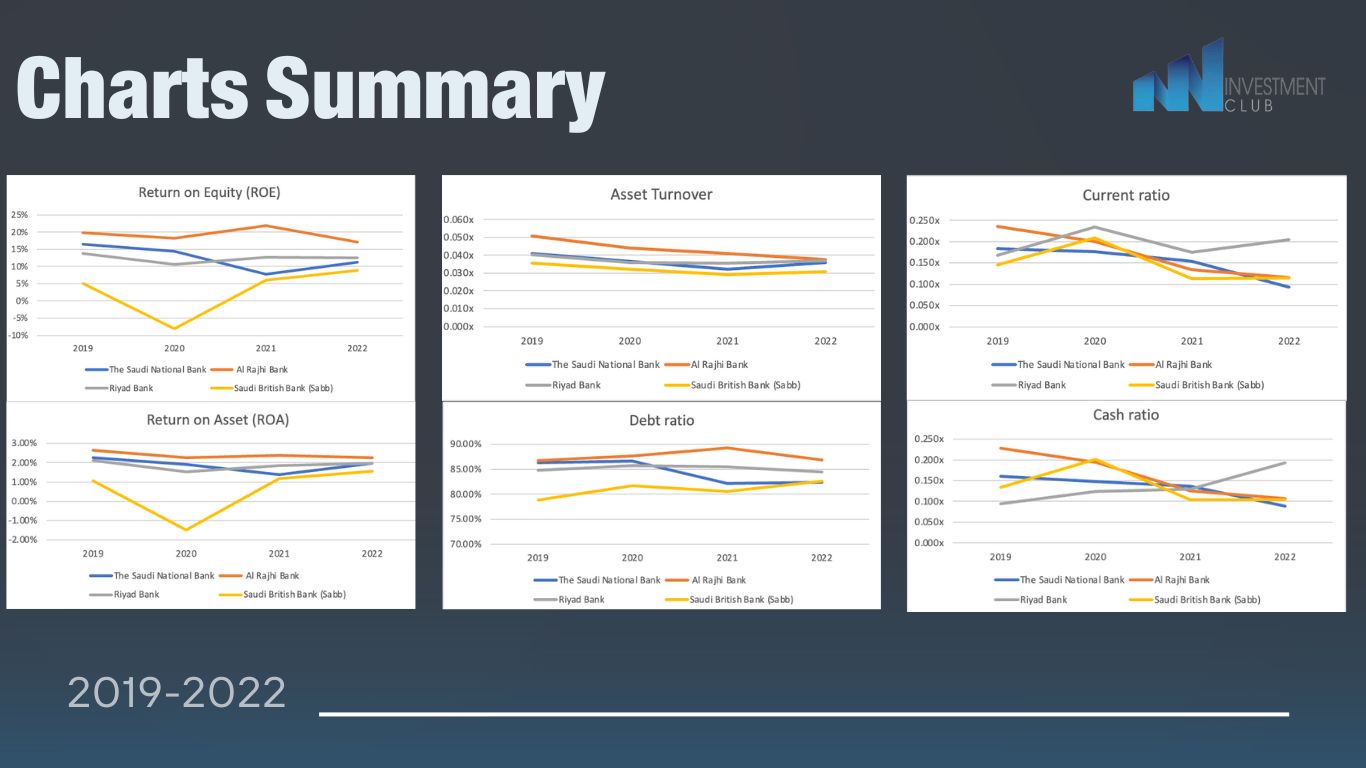
To see the full analysis:
Resources:
https://www.statista.com/statistics/1280616/saudi-arabia-market-share-by-major-commercial-banks/
https://www.alahli.com/ar-sa/pages/default.aspx
https://www.investopedia.com/articles/investing/122315/worlds-top-10-banks-jpm-wfc.asp
https://www.alliedmarketresearch.com/commercial-banking-market-A06184
https://www.argaam.com/ar/article/articledetail/id/1582837
https://www.alahli.com/ar-sa/about-us/Pages/default.aspx
https://www.alahli.com/ar-sa/about-us/pages/awards.aspx
https://www.riyadbank.com/documents/20121/0/Annual-Report-Arabic2022.pdf
https://www.argaam.com/ar/company/companyoverview/marketid/3/companyid/47
https://www.argaam.com/ar/company/companyoverview/marketid/3/companyid/48
https://www.sabinvest.com/ar/about-us/about-sab-invest
Prepared By:
Shahad AlRizehi
Reem Aljamaan
Jawaher Al-Qahtani
Alhanouf Alotaibi
Dema Alsharef
Joud Alfadhel
Sara Ziyad Alsalem